Gelatin-Alginate Coacervates Optimized by DOE to Improve Delivery of bFGF for Wound Healing
Abstract
:1. Introduction
2. Materials and Methods
2.1. Materials
2.2. Characterization of HWGA and LWGA
2.2.1. Circular Dichroism (CD)
2.2.2. Zeta Potential
2.3. Fabrication and Characterization of LWGA-SA and HWGA-SA Coacervates
2.3.1. Fabrication of Complex Coacervates
2.3.2. Freeze-Drying of Complex Coacervates
2.3.3. Trypsin Digestion Assay of Freeze-Dried bFGF Complex Coacervates
2.3.4. Encapsulation Efficiency of Complex Coacervates
2.3.5. In Vitro Release Test of Freeze-Dried bFGF Complex Coacervates
2.3.6. Phase Diagram of HWGA-SA
2.4. Design of Experiment (DOE)
2.5. In Vitro Cell Activity Study
2.5.1. In Vitro Cell Viability Assay
2.5.2. In Vitro Cell Scratch Wound Healing Assay
2.5.3. PICP ELISA Assay
2.6. Statistical Analysis
3. Results
3.1. Characterization of Gelatin
3.2. Characterization of HWGA-SA bFGF Complex Coacervates
3.2.1. Characterization and Morphology of HWGA-SA bFGF Complex Coacervates
3.2.2. Comparison of HWGA-SA and LWGA-SA Complex Coacervates
- Encapsulation efficiency (EE) of FITC labeled bFGF
- Trypsin digestion assay
- In vitro release assay
3.2.3. Phase Diagram of HWGA-SA Mixtures
3.3. Design of Experiments (DOE)
3.3.1. Optimization of the Formulation by Response Surface Design
3.3.2. Contour Plot of Overlapping Dependent Responses
3.4. In Vitro Cell Activity Study
3.4.1. In Vitro HDF Viability Assay
3.4.2. In Vitro HDF Scratch Wound Assay
4. Discussion
5. Conclusions
Author Contributions
Funding
Institutional Review Board Statement
Informed Consent Statement
Data Availability Statement
Conflicts of Interest
References
- Razzaghi, R.; Pourbagheri, H.; Momen-Heravi, M.; Bahmani, F.; Shadi, J.; Soleimani, Z.; Asemi, Z. The effects of vitamin D supplementation on wound healing and metabolic status in patients with diabetic foot ulcer: A randomized, double-blind, placebo-controlled trial. J. Diabetes Its Complicat. 2017, 31, 766–772. [Google Scholar] [CrossRef] [PubMed]
- Mokhtari, M.; Razzaghi, R.; Momen-Heravi, M. The effects of curcumin intake on wound healing and metabolic status in patients with diabetic foot ulcer: A randomized, double-blind, placebo-controlled trial. Phytother. Res. 2021, 35, 2099–2107. [Google Scholar] [CrossRef] [PubMed]
- Mariam, T.G.; Alemayehu, A.; Tesfaye, E.; Mequannt, W.; Temesgen, K.; Yetwale, F.; Limenih, M.A. Prevalence of diabetic foot ulcer and associated factors among adult diabetic patients who attend the diabetic follow-up clinic at the University of Gondar Referral Hospital, North West Ethiopia, 2016: Institutional-based cross-sectional study. J. Diabetes Res. 2017, 2017, 2879249. [Google Scholar] [CrossRef]
- Noor, S.; Zubair, M.; Ahmad, J. Diabetic foot ulcer—A review on pathophysiology, classification and microbial etiology. Diabetes Metab. Syndr. Clin. Res. Rev. 2015, 9, 192–199. [Google Scholar] [CrossRef] [PubMed]
- Hingorani, A.; LaMuraglia, G.M.; Henke, P.; Meissner, M.H.; Loretz, L.; Zinszer, K.M.; Driver, V.R.; Frykberg, R.; Carman, T.L.; Marston, W.; et al. The management of diabetic foot: A clinical practice guideline by the Society for Vascular Surgery in collaboration with the American Podiatric Medical Association and the Society for Vascular Medicine. J. Vasc. Surg. 2016, 63, 3S–21S. [Google Scholar] [CrossRef] [PubMed] [Green Version]
- Lau, H.C.; Kim, A. Pharmaceutical perspectives of impaired wound healing in diabetic foot ulcer. J. Pharm. Investig. 2016, 46, 403–423. [Google Scholar] [CrossRef]
- Berlanga, J.; Fernández, J.I.; López, E.; López, P.A.; Río, A.D.; Valenzuela, C.; Baldomero, J.; Muzio, V.; Raíces, M.; Silva, R.; et al. Heberprot-P: A novel product for treating advanced diabetic foot ulcer. MEDICC Rev. 2013, 15, 11–15. [Google Scholar] [CrossRef]
- Kizilay, E.; Kayitmazer, A.B.; Dubin, P.L. Complexation and coacervation of polyelectrolytes with oppositely charged colloids. Adv. Colloid Interface Sci. 2011, 167, 24–37. [Google Scholar] [CrossRef] [PubMed]
- Lau, H.C.; Jeong, S.; Kim, A. Gelatin-alginate coacervates for circumventing proteolysis and probing intermolecular interactions by SPR. Int. J. Biol. Macromol. 2018, 117, 427–434. [Google Scholar] [CrossRef] [PubMed]
- Jeong, S.; Kim, B.; Lau, H.C.; Kim, A. Gelatin-alginate complexes for EGF encapsulation: Effects of h-bonding and electrostatic interactions. Pharmaceutics 2019, 11, 530. [Google Scholar] [CrossRef] [PubMed] [Green Version]
- Jeong, S.; Kim, B.; Park, M.; Ban, E.; Lee, S.H.; Kim, A. Improved diabetic wound healing by EGF encapsulation in gelatin-alginate coacervates. Pharmaceutics 2020, 12, 334. [Google Scholar] [CrossRef] [PubMed] [Green Version]
- Timilsena, Y.P.; Akanbi, T.O.; Khalid, N.; Adhikari, B.; Barrow, C.J. Complex coacervation: Principles, mechanisms and applications in microencapsulation. Int. J. Biol. Macromol. 2019, 121, 1276–1286. [Google Scholar] [CrossRef] [PubMed]
- Chappell, J.C.; Song, J.; Burke, C.W.; Klibanov, A.L.; Price, R.J. Targeted delivery of nanoparticles bearing fibroblast growth factor-2 by ultrasonic microbubble destruction for therapeutic arteriogenesis. Small 2008, 4, 1769–1777. [Google Scholar] [CrossRef] [PubMed] [Green Version]
- Huang, Y.C.; Yang, Y.T. Effect of basic fibroblast growth factor released from chitosan–fucoidan nanoparticles on neurite extension. J. Tissue Eng. Regen. Med. 2016, 10, 418–427. [Google Scholar] [CrossRef] [PubMed]
- Guideline, I.H.T. Pharmaceutical Development Q8 (r2), Current Step 4 Version. In Proceedings of the International Conference on Harmonisation, Geneva, Switzerland, 11–16 November 2017. [Google Scholar]
- Ban, E.; Jang, D.J.; Kim, S.J.; Park, M.; Kim, A. Optimization of thermoreversible poloxamer gel system using QbD principle. Pharm. Dev. Technol. 2017, 22, 939–945. [Google Scholar] [CrossRef] [PubMed]
- Jeong, S.; Jeong, S.; Chung, S.; Kim, A. Revisiting in vitro release test for topical gel formulations: The effect of osmotic pressure explored for better bio-relevance. Eur. J. Pharm. Sci. 2018, 112, 102–111. [Google Scholar] [CrossRef]
- Díaz-Calderón, P.; Caballero, L.; Melo, F.; Enrione, J. Molecular configuration of gelatin–water suspensions at low concentration. Food Hydrocoll. 2014, 39, 171–179. [Google Scholar] [CrossRef]
- Scheffe, H. The simplex-centroid design for experiments with mixtures. J. R. Stat. Soc. Ser. B (Methodol.) 1963, 25, 235–251. [Google Scholar] [CrossRef]
- Greenfield, N.J. Using circular dichroism spectra to estimate protein secondary structure. Nat. Protoc. 2006, 1, 2876–2890. [Google Scholar] [CrossRef]
- Black, K.A.; Priftis, D.; Perry, S.L.; Yip, J.; Byun, W.Y.; Tirrell, M. Protein encapsulation via polypeptide complex coacervation. ACS Macro Lett. 2014, 3, 1088–1091. [Google Scholar] [CrossRef]
- Allen, D.M. The relationship between variable selection and data agumentation and a method for prediction. Technometrics 1974, 16, 125–127. [Google Scholar] [CrossRef]
- Qiu, S. Effects of Polymers on Carbamazepine Cocrystals Phase Transformation and Release Profiles. Ph.D. Thesis, Faculty of Health and Life Sciences De Montfort University, Leicester, UK, 2015. [Google Scholar]
- Seo, W.Y.; Kim, J.H.; Baek, D.S.; Kim, S.J.; Kang, S.; Yang, W.S.; Song, J.A.; Lee, M.S.; Kim, S.; Kim, Y.S. Production of recombinant human procollagen type I C-terminal propeptide and establishment of a sandwich ELISA for quantification. Sci. Rep. 2017, 7, 15946. [Google Scholar] [CrossRef] [PubMed] [Green Version]
- Grada, A.; Otero-Vinas, M.; Prieto-Castrillo, F.; Obagi, Z.; Falanga, V. Research techniques made simple: Analysis of collective cell migration using the wound healing assay. J. Investig. Dermatol. 2017, 137, e11–e16. [Google Scholar] [CrossRef] [PubMed] [Green Version]
- Johnson, N.R.; Ambe, T.; Wang, Y. Lysine-based polycation: Heparin coacervate for controlled protein delivery. Acta Biomater. 2014, 10, 40–46. [Google Scholar] [CrossRef] [PubMed] [Green Version]
- Werner, S.; Grose, R. Regulation of wound healing by growth factors and cytokines. Physiol. Rev. 2003, 83, 835–870. [Google Scholar] [CrossRef] [PubMed]
- Gainza, G.; Villullas, S.; Pedraz, J.L.; Hernandez, R.M.; Igartua, M. Advances in drug delivery systems (DDSs) to release growth factors for wound healing and skin regeneration. Nanomed. Nanotechnol. Biol. Med. 2015, 11, 1551–1573. [Google Scholar] [CrossRef] [PubMed]
- Schreier, T.; Degen, E.; Baschong, W. Fibroblast migration and proliferation during in vitro wound healing. Res. Exp. Med. 1993, 193, 195–205. [Google Scholar] [CrossRef] [PubMed]
- Choi, S.M.; Lee, K.M.; Kim, H.J.; Park, I.K.; Kang, H.J.; Shin, H.C.; Lee, J.W. Effects of structurally stabilized EGF and bFGF on wound healing in type I and type II diabetic mice. Acta Biomater. 2018, 66, 325–333. [Google Scholar] [CrossRef] [PubMed]
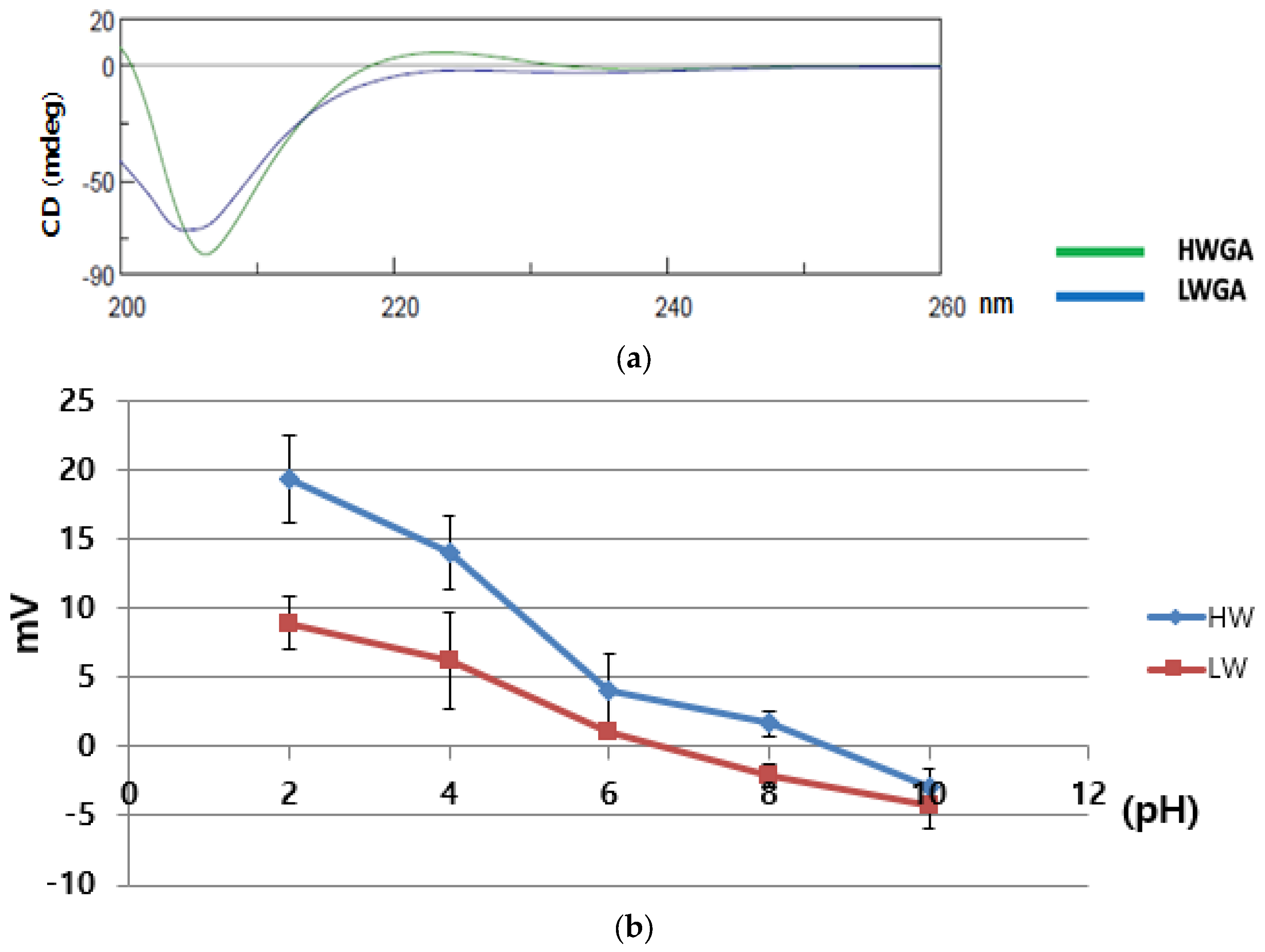
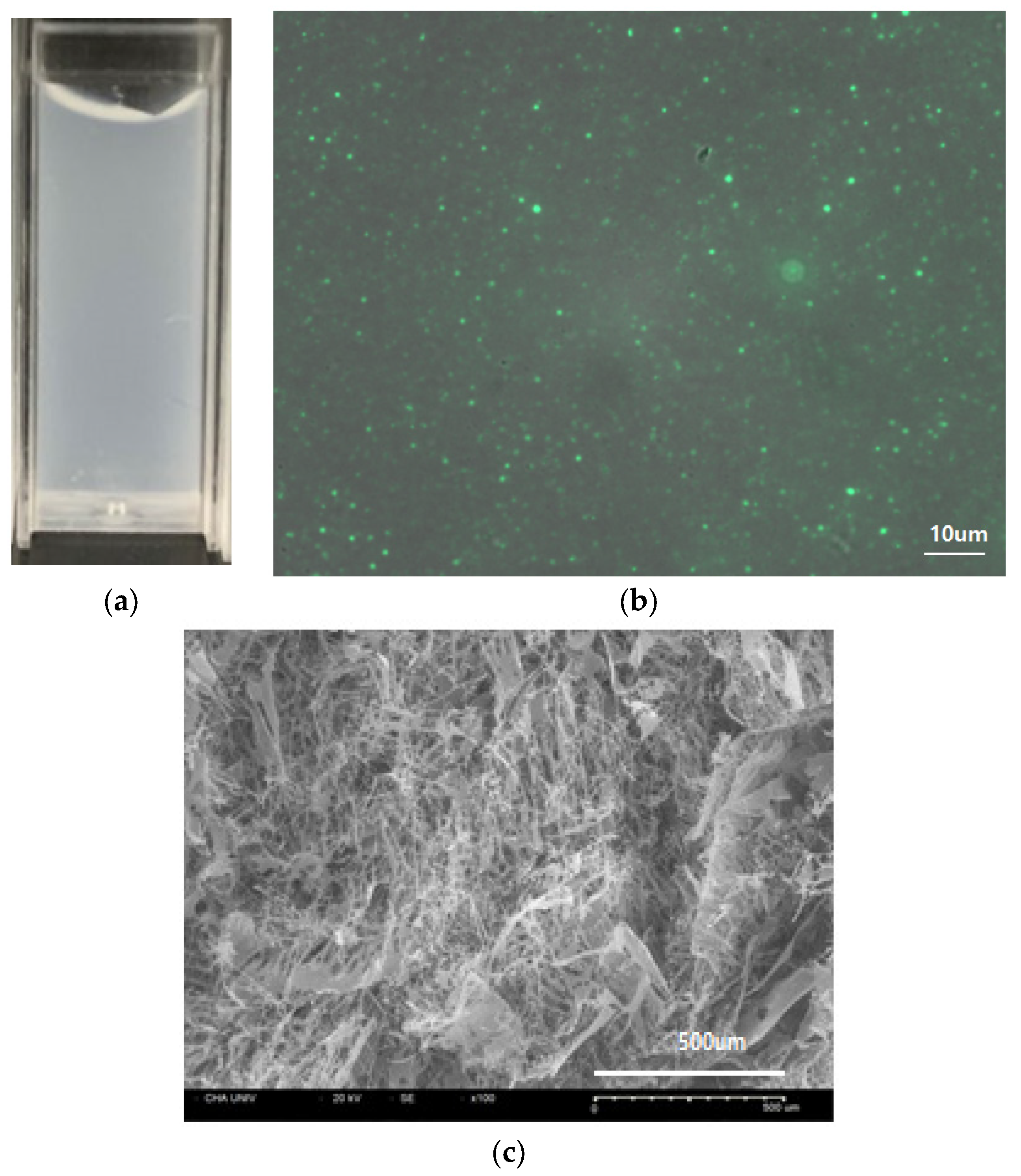
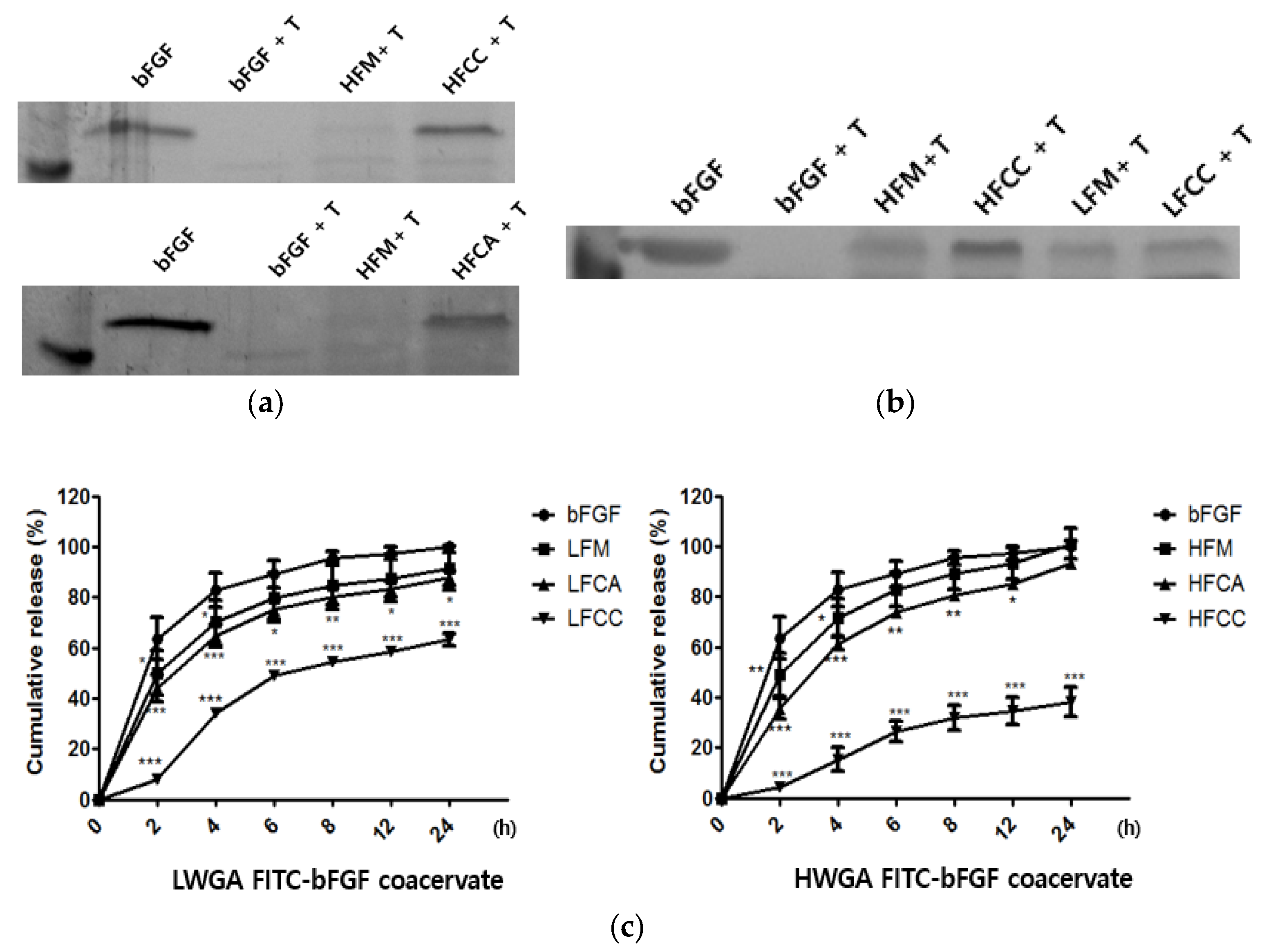
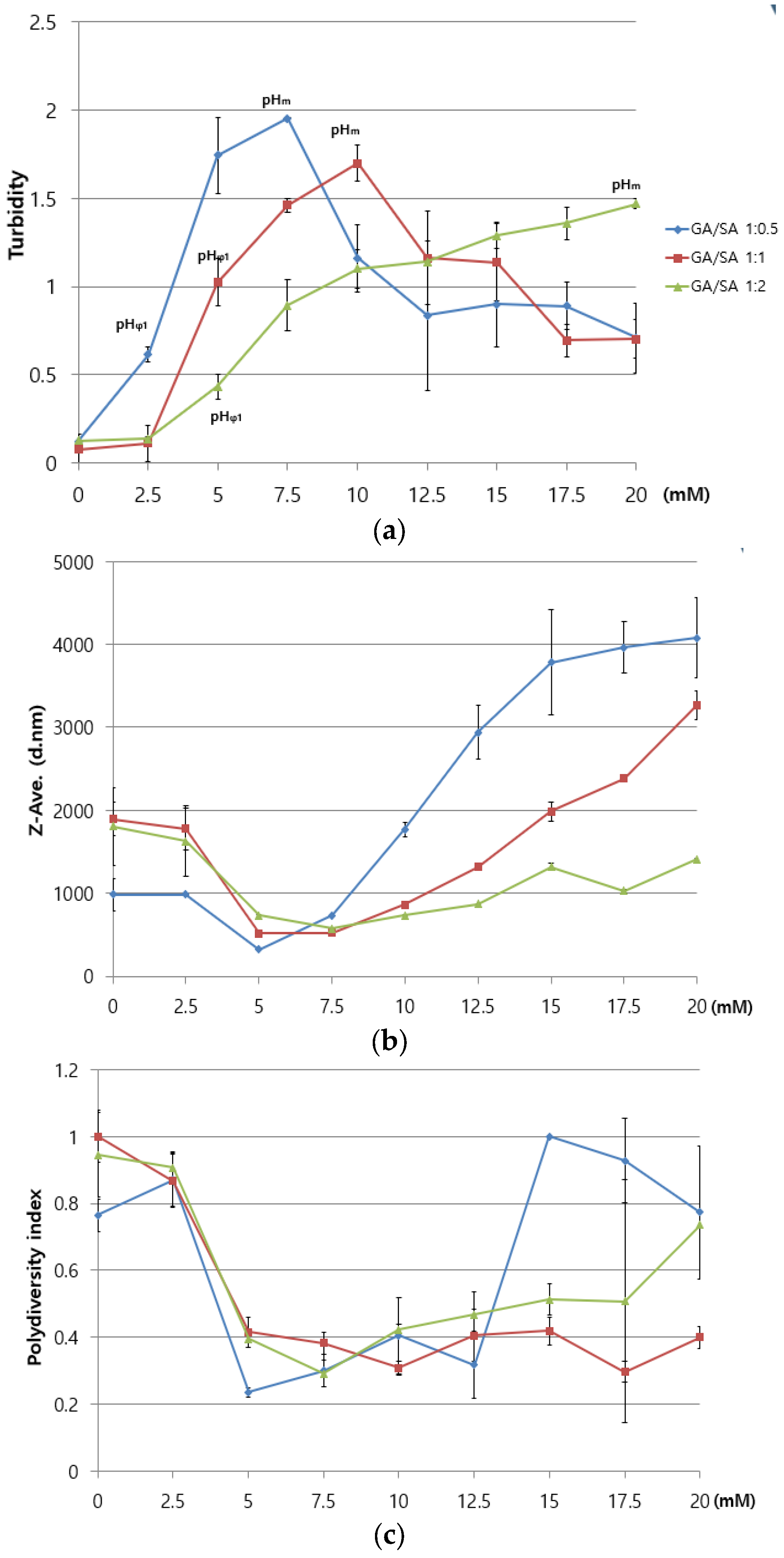
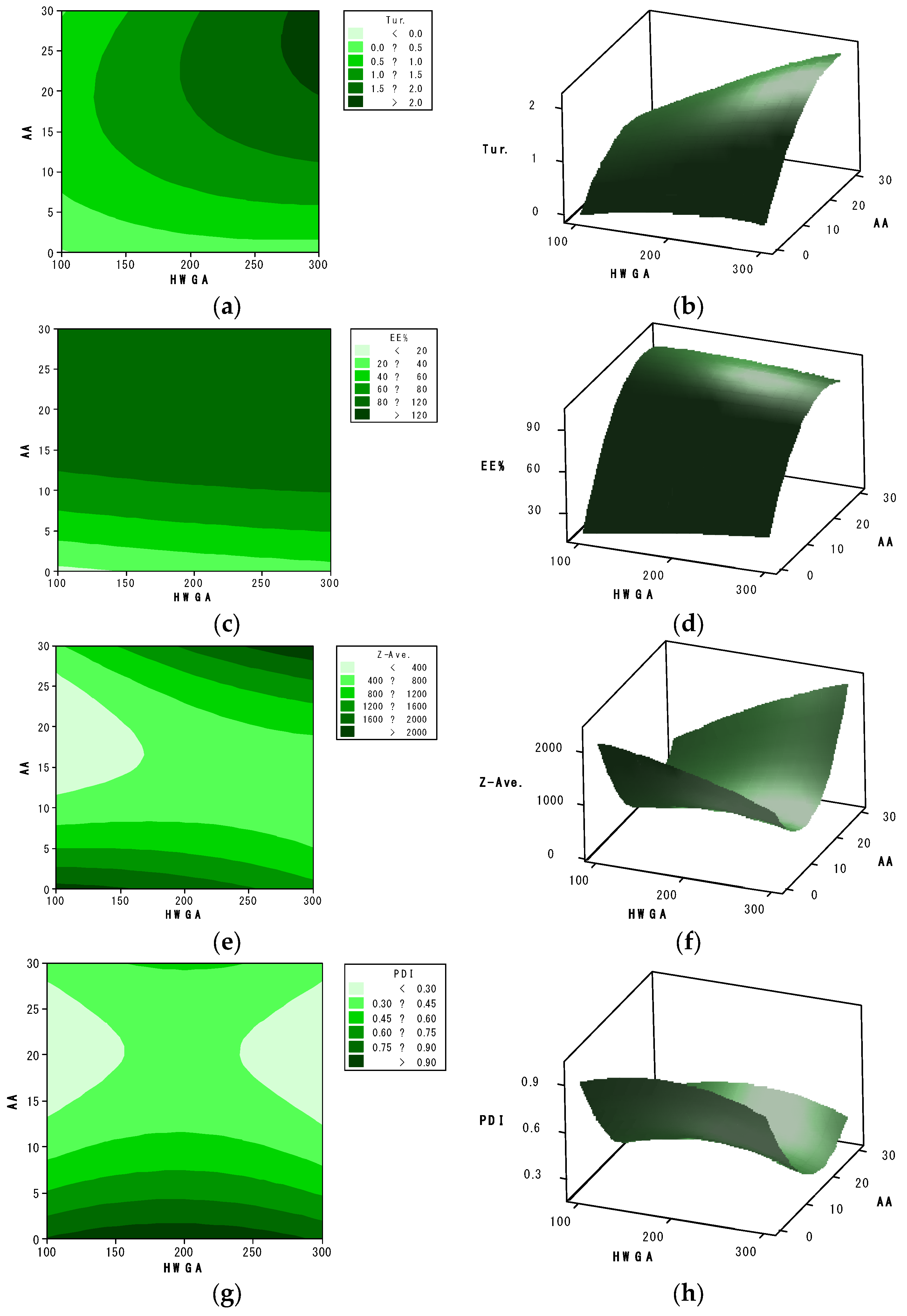
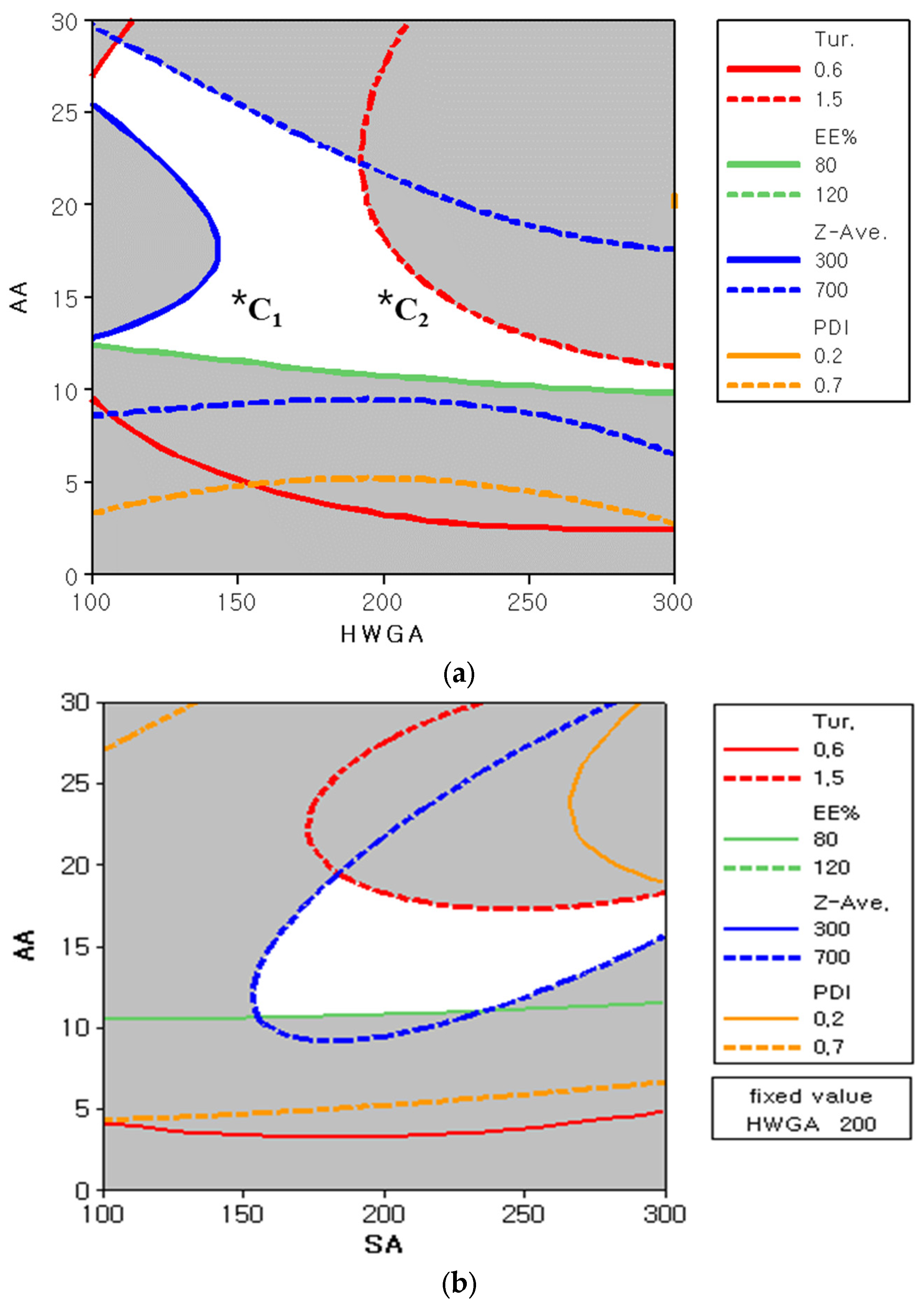
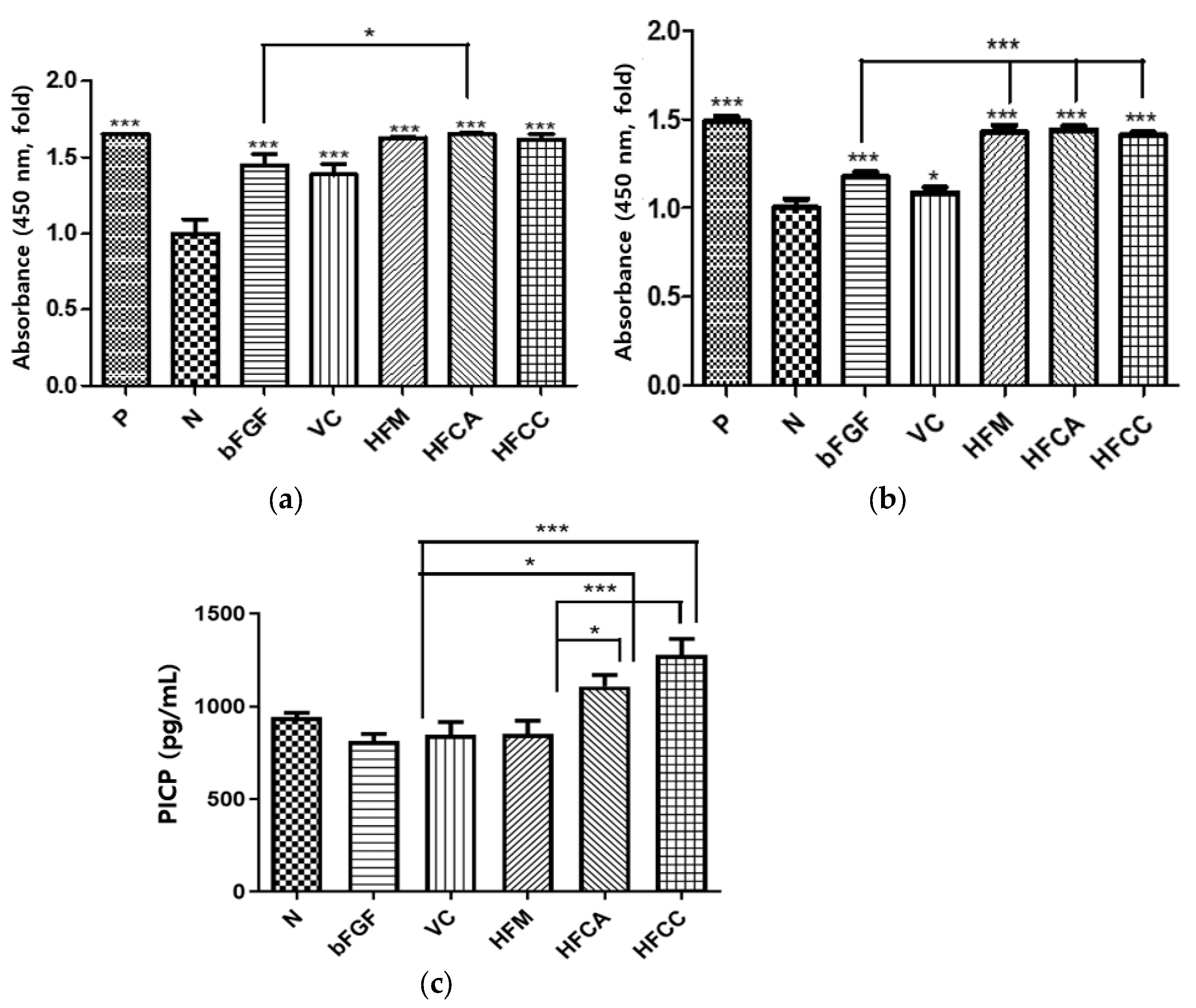
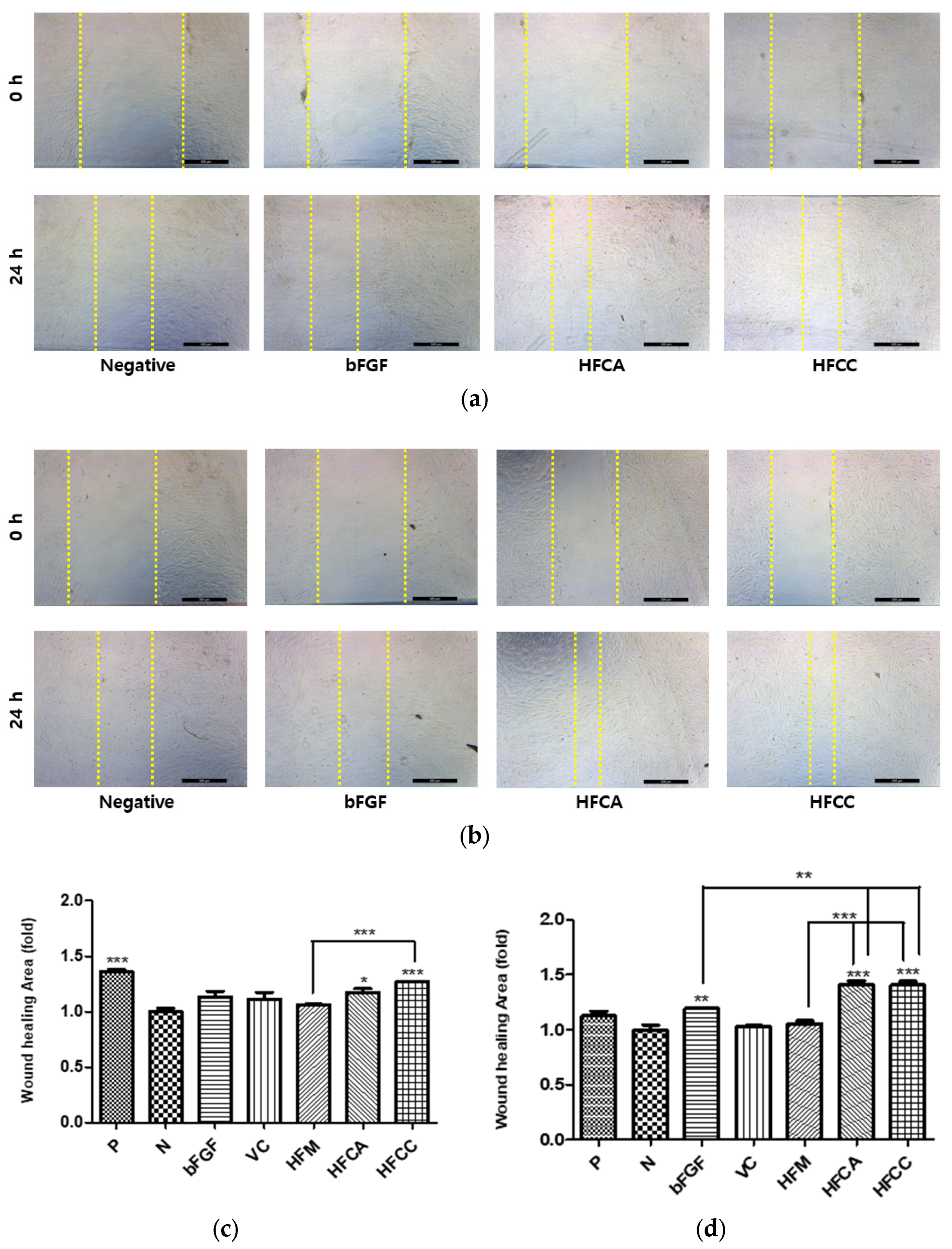
| Abbreviation | Composition |
|---|---|
| Negative Group | No treatment |
| bFGF Group | bFGF in solution |
| VC | Vehicle control |
| VCA | Freeze-dried vehicle control group containing acetic acid (empty HWGA-SA coacervates prepared with acetic acid). |
| VCC | Freeze-dried vehicle control group containing citric acid (empty HWGA-SA coacervates prepared with citric acid). |
| HFM | Freeze-dried physical mixture of HWGA, SA, and bFGF |
| HFCA | Freeze-dried HWGA-SA coacervates encapsulating bFGF, prepared with acetic acid |
| HFCC | Freeze-dried HWGA-SA coacervates encapsulating bFGF, prepared with citric acid |
| LFM | Freeze-dried physical mixture of LWGA, SA, and bFGF |
| LFCA | Freeze-dried LWGA-SA coacervates encapsulating bFGF, prepared with acetic acid |
| LFCC | Freeze-dried LWGA-SA coacervates encapsulating bFGF, prepared with citric acid |
| HWGA/SA Ratio | Acid Vol. (μL) * | pH | Turbidity | EE% | Z-Ave. (nm) | PDI | Zeta- Potential (mV) |
|---|---|---|---|---|---|---|---|
| 1:1 | 15 | 4.34 (±0.06) | 1.462 (±0.03) | 93.68 (±0.2) | 526.4 (±6.87) | 0.38 (±0.02) | −47.3 (±0.5) |
| Independent Variables | Level | |
|---|---|---|
| Low | High | |
| X1 (μL): 1% HWGA | 100 | 300 |
| X2 (μL): 1% SA | 100 | 300 |
| X3 (μL): 0.5 mM acetic acid | 0 | 30 |
| Dependent Responses | Goal | Lower Limit | Upper Limit |
|---|---|---|---|
| Y1: Tur. | Fit in range | 0.6 | 1.5 |
| Y2: EE (%) | Fit in range | 80 | 100 |
| Y3: Z-Ave. (d.nm) | Fit in range | 300 | 700 |
| Y4: PDI | Fit in range | 0.2 | 0.7 |
| Run | Independent Variables | Dependent Responses * | |||||
|---|---|---|---|---|---|---|---|
| X1 | X2 | X3 | Y1 | Y2 | Y3 | Y4 | |
| 12 | 200 | 300 | 30 | 1.6492 | 89.5774 | 925.50 | 0.20533 |
| 2 | 300 | 100 | 15 | 1.7953 | 94.7828 | 1867.67 | 0.28300 |
| 13 | 200 | 200 | 15 | 1.3577 | 93.8718 | 504.37 | 0.39400 |
| 14 | 200 | 200 | 15 | 1.3192 | 92.0561 | 470.70 | 0.35100 |
| 9 | 200 | 100 | 0 | 0.1229 | 26.9478 | 1060.73 | 0.86367 |
| 5 | 100 | 200 | 0 | 0.1301 | 11.5720 | 2785.67 | 1.00000 |
| 8 | 300 | 200 | 30 | 1.9769 | 91.5266 | 1673.00 | 0.26500 |
| 6 | 300 | 200 | 0 | 0.1261 | 33.2412 | 1576.00 | 0.98600 |
| 11 | 200 | 100 | 30 | 0.9860 | 92.0323 | 4384.67 | 1.00000 |
| 10 | 200 | 300 | 0 | 0.1357 | 23.8413 | 2876.00 | 1.00000 |
| 15 | 200 | 200 | 15 | 1.5181 | 90.4045 | 498.97 | 0.35900 |
| 3 | 100 | 300 | 15 | 0.4641 | 88.3662 | 678.50 | 0.28600 |
| 7 | 100 | 200 | 30 | 0.6018 | 92.9564 | 503.47 | 0.23867 |
| 4 | 300 | 300 | 15 | 1.8250 | 87.2374 | 832.00 | 0.24267 |
| 1 | 100 | 100 | 15 | 0.5082 | 89.7231 | 360.17 | 0.31467 |
| Responses | Model | R2 | Adjusted R2 | SD | Lack of Fit | Press |
| Turbidity | Full quadratic | 95.85 | 88.39 | 0.239 | 0.114 | 4.270 |
| EE | 99.63 | 98.96 | 3.176 | 0.173 | 724.411 | |
| Z-Ave. | 89.13 | 69.55 | 640.732 | 0.000 | 32,833,974 | |
| PDI | 91.70 | 76.76 | 0.161 | 0.012 | 2.070 | |
| Responses | Model | R2 | Adjusted R2 | SD | Lack of fit | Press |
| Turbidity | Quadratic | 87.40 | 50.18 | 0.330 | 0.075 | 3.435 |
| EE | 98.57 | 94.37 | 4.918 | 0.090 | 763.539 | |
| Z-Ave. | 42.36 | 0.00 | 1166.25 | 0.000 | 43,523,153 | |
| PDI | 77.87 | 11.60 | 0.208 | 0.009 | 1.388 | |
| Responses | Model | R2 | Adjusted R2 | SD | Lack of fit | Press |
| Turbidity | Special Cubic | 78.55 | 20.79 | 0.430 | 0.044 | 5.462 |
| EE | 69.21 | 0.00 | 22.848 | 0.004 | 17,737.5 | |
| Z-Ave. | 52.64 | 0.00 | 1057.18 | 0.000 | 37,269,026 | |
| PDI | 54.56 | 0.00 | 0.299 | 0.004 | 3.508 | |
| Responses | Model | R2 | Adjusted R2 | SD | Lack of fit | Press |
| Turbidity | Linear | 70.10 | 61.94 | 0.433 | 0.048 | N/A |
| EE | 68.16 | 59.47 | 1270.990 | 0.006 | N/A | |
| Z-Ave. | 5.87 | 0.00 | 640.732 | 0.000 | N/A | |
| PDI | 40.73 | 24.56 | 0.291 | 0.00 | N/A |
| Responses | Equation |
|---|---|
| Turbidity | Y1 = −0.828567 + 0.00650529X1 + 0.00354117X2 + 0.0457964X3 + 1.845 × 10−6X1X2 + 0.000229850X1X3 + 0.000108400X2X3 − 1.32454 × 10−5X12 − 1.7729 × 10−5X22 − 0.00247624X32 |
| EE | Y2 = −3.23038 + 0.1760285X1 + 0.0373900X2 + 7.44996X3 − 1.54714 × 10−4X1X2 − 0.00384982X1X3 + 0.000108598X2X3 − 1.42955 × 10−4X12 − 6.53892 × 10−5X22 − 0.148254X32 |
| Z-Ave. | Y3 = 1009.41 + 7.52714X1 − 5.40407X2 − 78.2790X3 − 0.0338500X1X2 + 0.396533X1X3 − 0.879072X2X3 − 0.0116976X12 + 0.0560215X22 + 5.60073X32 |
| PDI | Y4 = 0.400458 + 0.00450417X1 + 0.000308333X2 − 0.0374889X3 − 2.9667 × 10−7X1X2 − 6.72222 × 10−6X1X3 − 1.55167 × 10−4X2X3 − 1.15625 × 10−5X12 − 2.92083 × 10−6X22 + 0.00164463X32 |
| Responses | Model Prediction Value (Y) (X1, X2, X3) | Experimental Value (Y’) (X1, X2, X3) | Percentage of Prediction Error (|Y−Y’|/Y%) | |||
|---|---|---|---|---|---|---|
| C1 | C2 | C1 | C2 | C1 | C2 | |
| Turbidity (Y1) | 1.11614 | 1.39816 | 1.101 | 1.4238 | 1.38 | 1.80 |
| EE (Y2) | 90.3272 | 92.2060 | 95.89 | 95.03 | 6.16 | 3.06 |
| Z-Ave. (Y3) | 361.276 | 490.948 | 439.9 | 519.2 | 17.87 | 5.44 |
| PDI (Y4) | 0.343038 | 0.367753 | 0.298 | 0.353 | 15.11 | 4.18 |
Publisher’s Note: MDPI stays neutral with regard to jurisdictional claims in published maps and institutional affiliations. |
© 2021 by the authors. Licensee MDPI, Basel, Switzerland. This article is an open access article distributed under the terms and conditions of the Creative Commons Attribution (CC BY) license (https://creativecommons.org/licenses/by/4.0/).
Share and Cite
Kim, B.; Ban, E.; Kim, A. Gelatin-Alginate Coacervates Optimized by DOE to Improve Delivery of bFGF for Wound Healing. Pharmaceutics 2021, 13, 2112. https://doi.org/10.3390/pharmaceutics13122112
Kim B, Ban E, Kim A. Gelatin-Alginate Coacervates Optimized by DOE to Improve Delivery of bFGF for Wound Healing. Pharmaceutics. 2021; 13(12):2112. https://doi.org/10.3390/pharmaceutics13122112
Chicago/Turabian StyleKim, ByungWook, Eunmi Ban, and Aeri Kim. 2021. "Gelatin-Alginate Coacervates Optimized by DOE to Improve Delivery of bFGF for Wound Healing" Pharmaceutics 13, no. 12: 2112. https://doi.org/10.3390/pharmaceutics13122112
APA StyleKim, B., Ban, E., & Kim, A. (2021). Gelatin-Alginate Coacervates Optimized by DOE to Improve Delivery of bFGF for Wound Healing. Pharmaceutics, 13(12), 2112. https://doi.org/10.3390/pharmaceutics13122112






